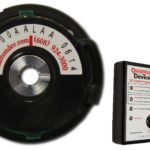Edited by Zak Khan || Smart encoders are encoders that contain hardware and associated software that let them dynamically change settings such as resolution and output circuit type. So one model of smart encoder can often replace many different models of traditional encoders.
Read the related encoder FAQ: Why do some encoders have embedded microprocessors for signal processing?
Smart-encoder implementations abound. Some come with standard connectivity ports and networking capabilities (such as USB and EtherCAT) as well as open-source software compatibility. Others come with proprietary connectors and software designed only to work with one manufacturer’s encoder. Engineers can also write software in-house as well. So the OEM must have programmers on staff or hire them to get outsourced encoder programming. While this may seem like an option to get the best-tailored application, keep in mind that having encoder programmers on staff or hire adds expense and design time to machine builds. That’s unnecessary when off-the-shelf or manufacturer-provided software works just as well.
How to configure smart encoders
No matter how an end user or OEM programs an encoder, the basic principle is the same. In short, a smart encoder connects to a computer and the user configures it through software to get target settings. Then the smart encoder sends data back to the computer or other I/O system if applicable.
The ability to adjust resolution on-the-fly is especially useful because it doesn’t force OEMs and end users to pick resolution right away.
In contrast, manufacturers must set the resolution of a traditional encoder when the OEM or user orders it … so resolution is set for the life of the device.
Smart encoders allow the resolution to change at any time during operation, which boosts flexibility. It also decreases costs because OEMS don’t need to buy many encoders for various resolutions — as again, one encoder can serve any number of resolutions.
Smart encoders also allow software upgrades. Both the computer software and encoder firmware are changeable by the end user. (If any faults exist in a traditional encoder, the engineer must order a replacement — causing downtime and expense.) Smart encoders can even make use of software to solve software problems or temporarily compensate for hardware difficulties. Diagnostics let engineer proactively compensate for issues as well. Continuously encoder-health reporting minimizes downtime, as end users don’t need to wait for the encoder to break before replacing it. Instead, plant personnel can monitor it in software and order replacement parts upfront — and even perform system upgrades before critical failures occur.
For more information on smart encoders, read:
BEI Sensors: Omnicoder: Programmable Resolution Encoder
Tri-Tronics: Programmable Encoders
PDF Download: Rotary actuators, displays & interfaces 2013







Leave a Reply
You must be logged in to post a comment.